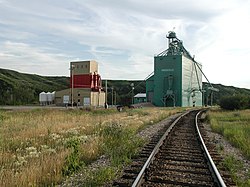Rosebud, Alberta is a hamlet in southern Alberta, Canada within Wheatland County.[3] Previously an incorporated municipality, Rosebud dissolved from village status on January 1, 1946, to become part of the Municipal District of Grasswold No. 248.[1]
Rosebud | |
|---|---|
Hamlet | |
 Rosebud Grain Elevator | |
| Coordinates: 51°18′00″N 112°57′04″W / 51.300°N 112.951°W | |
| Country | Canada |
| Province | Alberta |
| Region | Southern Alberta |
| Municipal district | Wheatland County |
| Dissolved | January 1, 1946[1] |
| Area (2021)[2] | |
| • Land | 0.73 km2 (0.28 sq mi) |
| Population (2021)[2] | |
| • Total | 112 |
| • Density | 153.4/km2 (397/sq mi) |
| Time zone | UTC−07:00 (MST) |
| • Summer (DST) | UTC−06:00 (MDT) |
| Postal code | T0J 2T0 |
| Area code | +1-403 |
| Highways | Highway 840 |
| Waterways | Rosebud River |
Rosebud is located on Highway 840, approximately 100 kilometres (62 mi) northeast of Calgary and 25 kilometres (16 mi) southwest of Drumheller. It sits in a sheltered valley on the Rosebud River near the edge of the Canadian Badlands. This area was called Akokiniskway by the Blackfoot people, which translates roughly to "by the river of many roses".

History edit
The hamlet was founded in the 1885 by James Wishart. While following the Gleichen Trail to Montana with his family, they awoke to the river valley covered by wild roses, Alberta's official flower. Wishart then reportedly said, "Here's the promised land, we go no further."[4]
The beauty of the valley has attracted many people throughout the years, from nature lovers to artists. Notable artists A. Y. Jackson and H. G. Glyde, members of the Group of Seven, spent a summer in 1944 painting in the area.[5]
Over the years, farming and coal mining have been the primary industries. In 1972 the Severn Creek School was shut down as part of an Alberta wide education consolidating process and local children were bused to Standard and Drumheller. This resulted in many of the local businesses being closed and the hamlet population dropped to under a dozen people. However, the farming community of around 400 still support a seed cleaning plant.
Easter 1973, a group of young adults from Calgary brought about 40 teenagers out and camped in the then empty mercantile. This pilot event evolved into a summer camp initially funded by a grant from the Alberta government and then supported as Rosebud Camp of the Arts by Crescent Heights Baptist Church in Calgary. In 1977 a high school was founded using the old buildings of the town as classrooms and emphasizing practical, visual, music and the performing arts in its curriculum. In the 1980s, Rosebud School of the Arts began to run theatre, which eventually developed into Rosebud Theatre and the school shifted its emphasis to post-secondary education. Today Rosebud Theatre runs as a fully professional company that offers programming year round and is a tourist attraction drawing patrons from Calgary and Drumheller.
Demographics edit
In the 2021 Census of Population conducted by Statistics Canada, Rosebud had a population of 112 living in 43 of its 54 total private dwellings, a change of 28.7% from its 2016 population of 87. With a land area of 0.73 km2 (0.28 sq mi), it had a population density of 153.4/km2 (397.4/sq mi) in 2021.[2]
As a designated place in the 2016 Census of Population conducted by Statistics Canada, Rosebud had a population of 87 living in 29 of its 30 total private dwellings, a change of -1.1% from its 2011 population of 88. With a land area of 0.29 km2 (0.11 sq mi), it had a population density of 300.0/km2 (777.0/sq mi) in 2016.[6]
Economy edit
Currently the primary industries within the hamlet are tourism and the arts, with the Rosebud Theatre drawing an estimated 40,000 visitors to the hamlet annually.[7] The theatre grew out of church outreach programme for Calgary youth.[8][9] Agriculture along with oil and gas production are significant industries in the surrounding area.
See also edit
References edit
- ^ a b "Table 6a: Population by census divisions and subdivisions showing reorganization of rural areas, 1931-1946". Census of the Prairie Provinces, 1946. Vol. I: Population. Ottawa: Dominion Bureau of Statistics. 1949. p. 420.
- ^ a b c "Population and dwelling counts: Canada and designated places". Statistics Canada. February 9, 2022. Retrieved February 10, 2022.
- ^ "Specialized and Rural Municipalities and Their Communities" (PDF). Alberta Municipal Affairs. January 12, 2022. Retrieved January 21, 2022.
- ^ Hymas, Kay: Akokiniskway, by the river of many roses, page 39. Rosebud Historical Society. 1983.
- ^ Akokiniskway, by the river of many roses, page 33. Rosebud Historical Society. 1983.
- ^ "Population and dwelling counts, for Canada, provinces and territories, and designated places, 2016 and 2011 censuses – 100% data (Alberta)". Statistics Canada. February 8, 2017. Retrieved February 13, 2017.
- ^ "Cultural Beacon Shines Bright in Rosebud". Rosebud Theatre Press Release. Archived from the original on December 1, 2012. Retrieved June 3, 2013.
- ^ Bentall, Shirley (1975). Buckboard to brotherhood : the Baptist churches in Calgary. Calgary, Alberta: Century Calgary Publications. p. 112.
- ^ "A Brief History". Rosebud School of the Arts. Archived from the original on May 9, 2013. Retrieved June 4, 2013.
- Hymas, Kay: Akokiniskway, by the river of many roses, page 39. Rosebud Historical Society. 1983.
- Akokiniskway, by the river of many roses, page 33. Rosebud Historical Society. 1983.
